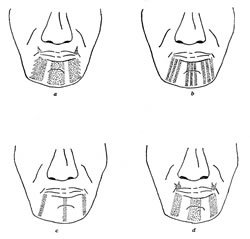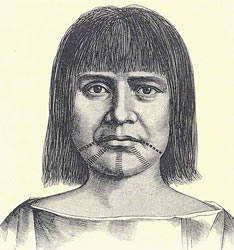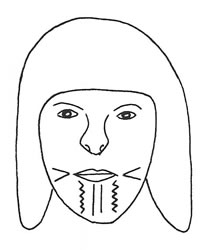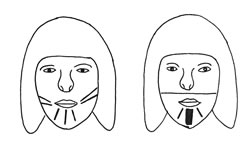Marks of Transformation:
Tribal Tattooing in California and the American Southwest
Article © 2010 Lars Krutak
Tattoo “Doctors”
Apparently, Hupa men were also employed to make tattoos for female members of the tribe. In 1928, Hupa elder Sam Brown recounted a tattooing session he witnessed to anthropologist Edward Sapir:
Long ago, I saw it, how in the fall girls raised their little burden baskets in the morning and went off after fir pitch. They all went across the river. And then Water-flows-past-him-place, now dead, came across with them in order to interpret for them with the Yurok Indian who understood chin tattooing. Widow-he-has-been-made, he used to be called.
He said to the girls, “Now! Go to get pitch!” Each of them carried out pitch in her burden basket to where that Yurok Indian was staying across from Ta’k’imiłdiŋ village on the gravel. And then he built two roofed structures circle-wise with rocks, and in them he dumped the pitch. And then he built in the rocks all around until they met on top of the structure [like an igloo]. Then with fire he poked the pitch, did this to the pitch in both places. And then, after a while, when it burned up, after he had taken the rocks off from the fire, he scraped from them all the fine particles of black which had been thrown on by the fire. When he had done this to all the rocks, everyone of the girls sat down. |
|
 |
Hupa. Women’s facial styles, 1910. |
With soot mixed with marrow they were already marked [stenciled] down their chins in whatever way they wanted it. And then one of them first he tattooed the chin, with a quartz sliver [lancet]. He keeps cutting it, he keeps cutting at it in short dabs. With a stick he scraped off the blood. And then he keeps putting in that pitch soot. Finally, when he has tattooed the chins of one or two girls, night falls.
And then, when he has tattooed the chins of all of them, they do not eat, anything white [in color] – only seaweed and anything blue, such as salal berries, so that their chin tattoo marks may turn blue. But if she eats anything white, her chin cannot turn blue.
They used to say, if a girl’s chin was not tattooed, “You, are you going to look like a man? Lizards run into your mouth, your chin is not tattooed. Your ears are not punched [pierced] through.”
In 1898, C. Hart Merriam noted that a Hupa woman’s chin markings was reserved for woman “of pure blood [and] none of mixed origin are permitted to wear it.”
|
|
Identification & “Money” Marks
According to the ethnologist Stephen Powers who lived and visited with several central and northern Californian tribes in the 1870s, one of the primary purposes of facial tattooing was for identification purposes. This belief was probably based on the fact that there were numerous groups inhabiting the region and many of them had a long history of conflict with one another. This fact, combined with the multiplicity of facial designs indigenous to the area and Native testimony, lend support to Powers’ observations. |
For example, a Bear River Mattole women stated about 1920: “It is said women were tattooed so that they could be told by their marks. Someone sat on my legs and held my arms and head. I was a small girl at the time, not yet having reached puberty. One could not eat for a long time, because the mouth and lips swelled so badly. The material used was obtained by burning pitch. A flat rock was supported by a stone on each side. A little fire with pitch in it was placed underneath. The next morning the stone would be cold and the soot could be recovered.”
| 
|
 |
 |
Pomo. By 1900, tattooing was quite rare among the Pomo. When it was seen, however, designs usually consisted of from one to four straight vertical lines at the corners of the mouth. Zigzagging lines were also employed, but not as commonly as the Yuki immediately to the north. Informants interviewed one hundred years ago reported that the zigzag motif was called “striped watersnake” or simply “zigzag”. The same pattern was commonly incorporated into basketry designs for which the Pomo were famous.
One elder interviewed around 1900 stated that women did not originally tattoo their faces, but when the white men came into the country the mothers tattooed the faces of their daughters to make them repugnant to the foreigners who were in the habit of kidnapping girls.
The two tattooed women seen here in the image above right represent the daughter of Chief Sebastian at Sebastapol (left) and a “Metumwah” Pomo woman at right. |
Another Bear River Mattole informant corroborated the story and reported that both sexes tattooed for purposes of identification and adornment. By 1930, the male identification pattern had been forgotten, but it is said when boys or girls became separated or stolen from the tribe, they could always be identified by their tattoo marks. Zigzag tattoo patterns running from shoulder to shoulder in the form of a necklace where also used by men for ornamental, and perhaps ranking, purposes.
Next Page |
1
|
2 |
3 |
4 |
5 |
6 |
7 |
Museum photo gallery of the images
on this page may be seen here. |




